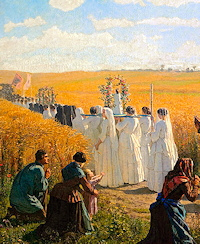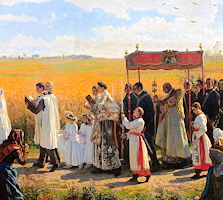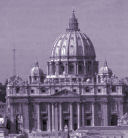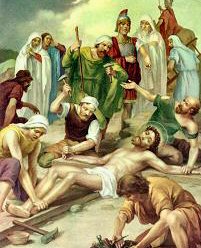Lent: March 15th
Saturday of the First Week of Lent; Ember Saturday
Other Commemorations: St. Louise de Marillac, Widow (RM)
» Enjoy our Liturgical Seasons series of e-books!
The Roman Martyrology commemorates St. Louise de Marillac (1591-1660). She was born in 1592, and married in 1613. When her husband died she made a vow of widowhood and devoted herself entirely to works of charity. St. Vincent de Paul, who became her spiritual director, gradually initiated her into his own charitable works for the poor and afflicted, and in 1639 they founded the Congregation of the Daughters of Charity to which St. Louise dedicated the rest of her life. She was canonized by Pope Pius XI on March 11, 1934.
It is Ember Saturday of Lent or Spring Embertide. See Contemporary Observation of Ember Days and Lenten Ember Days for more information.
The traditional Station Church today is at St. Peter's Basilica. In this basilica at the Vatican priestly ordinations were formerly held on Ember Saturday (or early Sunday morning preceded by a long vigil). The 1962 Missal includes three extra Lessons, a relic of those read formerly during the night. The current Lectionary's first reading from Deuteronomy 26:16-19 is one of the readings from the former missal.
Meditation for Ember Saturday of the First Week of Lent—Spring Ember Days
 According to the tradition of the Church, the first week of Lent is the week of Spring Ember Days. Ember Days are specifically a tradition of the Church in Rome, its roots partly to be found in the Old Testament — where for example the prophet Zechariah attests four seasons of fasting in the years — and partly in the tradition of pagan Rome, with its festivals of seedtime and harvest still recalled in our own days. So we have this fine combination of creation and biblical history, a combination which is a sign of true catholicity. In the celebrations of these days we receive the year from the hand of God, receive our time from the Creator and Redeemers, and confide sowing and harvesting to his goodness, thanking him for the fruit of the earth and our work. The celebration of the Ember Days corresponds to the fact that "the creating waits with eager longing for the revealing of the sons of God" (Rom 8:19): through our prayer, creation enters into the Eucharist, has part in the praise of God.
According to the tradition of the Church, the first week of Lent is the week of Spring Ember Days. Ember Days are specifically a tradition of the Church in Rome, its roots partly to be found in the Old Testament — where for example the prophet Zechariah attests four seasons of fasting in the years — and partly in the tradition of pagan Rome, with its festivals of seedtime and harvest still recalled in our own days. So we have this fine combination of creation and biblical history, a combination which is a sign of true catholicity. In the celebrations of these days we receive the year from the hand of God, receive our time from the Creator and Redeemers, and confide sowing and harvesting to his goodness, thanking him for the fruit of the earth and our work. The celebration of the Ember Days corresponds to the fact that "the creating waits with eager longing for the revealing of the sons of God" (Rom 8:19): through our prayer, creation enters into the Eucharist, has part in the praise of God.
In the fifth century however, the Ember Days took on another dimension, becoming feasts of the spiritual harvest of the Church, feasts of Holy Orders. The arrangement of stational churches for these three days is very significant: Wednesday, Saint Mary Major; Friday, the Church of the Twelve Apostles; Saturday, St. Peter's. On the first day, the Church presented the ordinands to Our Lady, to the Church in person. "Sub tuum praesidium confugimus" (We fly to your protection), a Marian prayer of the third century, comes to mind here when we meditate on this action. The Church confides her ministers to the Mother: "Behold your mother". This word from the Cross encourages us to seek refuge close to our Mother. Under Our Lady's mantle, we are safe. In all our difficulties we can turn with immense faith to our Mother, we venture to take up our service.
 The Friday was the day of the Twelve Apostles' church. As "fellow-citizens of the saints and servants of God" we "are built upon the foundation of the apostles and prophets" (Eph 2:19-20). Only in the context of the apostolic succession, of the faith of the Apostles and of the apostolic structure of the Church, with a true priestly system, that is, can we construct the living temple of God. The ordinations themselves took place during the night of Saturday, with a view to Sunday morning in St. Peter's. Thus the Church expressed the unity of the priestly system in union with Peter, as Jesus at the beginning of his public life had called Peter and his "partners" (Lk 5:10), after he had been teaching from Simon's boat.
The Friday was the day of the Twelve Apostles' church. As "fellow-citizens of the saints and servants of God" we "are built upon the foundation of the apostles and prophets" (Eph 2:19-20). Only in the context of the apostolic succession, of the faith of the Apostles and of the apostolic structure of the Church, with a true priestly system, that is, can we construct the living temple of God. The ordinations themselves took place during the night of Saturday, with a view to Sunday morning in St. Peter's. Thus the Church expressed the unity of the priestly system in union with Peter, as Jesus at the beginning of his public life had called Peter and his "partners" (Lk 5:10), after he had been teaching from Simon's boat.
The first week of Lent is a week of seedtime: let us entrust to God's goodness the fruits of the earth and the work of human hands, so that all may receive daily bread, so that hunger may be taken from the earth. Let us entrust to God's goodness also the seed of the word, so as to revive in ourselves the gift of God which is in us "through the laying-on of the hands" of the bishop (2 Tim 1:6), in the apostolic succession, in union with Peter. Let us thank God who has protected us in all temptations and difficulties, and pray, in the words of the prayer after Communion, that God will extend to us his favor, that is, his eternal love, himself, the gift of the Holy Spirit, and that he will grant us also the temporal consolations that we need in our weakness:
"You have strengthened us Lord, through these mysteries and nourished us with your heavenly sacrament. Stay with us to comfort us and save us, and never cease to show us your favour".Let us make our prayer "through Christ our Lord". Let us pray as under our Mother's mantle. Let us pray as trustful children. The word of the Redeemer stands firm: "Have faith—I have overcome the world" (Jn 16:33).
—Cardinal Joseph Ratzinger (Pope Benedict XVI), Journey Towards Easter

Saturday of the First Week of Lent (Ember Saturday)
Station with San Pietro in Vaticano (St. Peter's in the Vatican):
The Station is in the Basilica of St. Peter in the Vatican, where the people would assemble towards evening, that they might be present at the ordination of the priests and sacred ministers. The original basilica was built by Constantine in 323 over the place where St. Peter was buried.
For more on San Pietro in Vaticano, see:
- The Station Churches of Rome
- Rome Art Lover
- Roman Churches
- PNAC
- St. Peter's Basilica Info
- Aleteia
- Station Church
- The Catholic Traveler
For further information on the Station Churches, see The Stational Church.
St. Louise de Marillac
 St. Louise de Marrillac married an official of the royal court, Antony Le Gras, and after his death in 1625 was an active supporter of the charitable work of St Vincent de Paul, who came to put more and more reliance on her. Mademoiselle Le Gras, as she was known, became the co-founder with him of the Daughters of Charity, whose 'convent is the sick-room, their chapel the parish church, their cloister the city streets'; it was she who drew up the first draft of their rule of life. Her clear intelligence and wide sympathy played a big part in the beginnings of the congregation, whose aspirants she trained and whose rapid growth involved responsibilities which largely fell on her. At the time of her death there were already over forty houses of the sisters in France, the sick poor were looked after at home in twenty-six Parisian parishes, hundreds of women were given shelter, and there were other undertakings as well. St Louise was not physically robust, but she had great powers of endurance, and her selfless devotion was a source of incalculable help and encouragement to Monsieur Vincent.
St. Louise de Marrillac married an official of the royal court, Antony Le Gras, and after his death in 1625 was an active supporter of the charitable work of St Vincent de Paul, who came to put more and more reliance on her. Mademoiselle Le Gras, as she was known, became the co-founder with him of the Daughters of Charity, whose 'convent is the sick-room, their chapel the parish church, their cloister the city streets'; it was she who drew up the first draft of their rule of life. Her clear intelligence and wide sympathy played a big part in the beginnings of the congregation, whose aspirants she trained and whose rapid growth involved responsibilities which largely fell on her. At the time of her death there were already over forty houses of the sisters in France, the sick poor were looked after at home in twenty-six Parisian parishes, hundreds of women were given shelter, and there were other undertakings as well. St Louise was not physically robust, but she had great powers of endurance, and her selfless devotion was a source of incalculable help and encouragement to Monsieur Vincent.
—Dictionary of Saints by Donald Attwater
Patronage: disappointing children; loss of parents; people rejected by religious orders; sick people; Christian Social Workers (proclaimed on 12 February 1960 by Pope John XXIII); Vincentian Service Corps; widows
Symbols and Representation: widows' clothing; Saint Louise is depicted wearing the original Vincentian habit of grey wool with a large headdress of white linen (typical of poor women in 17th century Brittany), perhaps with an infant in her arms.
Highlights and Things to Do:
- Read more about St. Louise:
- Teach your children this simple morning aspiration by St. Louise: "Grant me the grace to spend this day without offending You and without failing my neighbor."
- Find out more about the Daughters of Charity of St. Vincent de Paul which she helped found.<.li>
- St. Louise's remains are enshrined in the Chapel of the Miraculous Medal in the motherhouse of the Daughters of Charity in Paris. Her body is not incorrupt, but rather the body in the chapel is actually a wax effigy, containing her bones.
- Begin planning a family Passion presentation or play in which all can participate. You may want to plan this for the end of Lent — Spy Wednesday or Holy Thursday would be particularly appropriate days for this.






